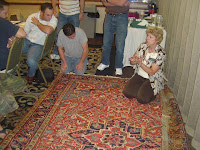



Besides selling Oriental, area and Persian rugs, we do rug cleaning and repair. This has its own advantages and disadvantages. The down side is the hassles we encounter. Some of the customers who call us, only ask about the cost and these are the ones who want to shop around and get a deal. The second type of the customers are those who ask how we clean their Oriental carpets. For the second type, usually the quality of the work and its process is more important than the mere low pricing.
The best way of cleaning a rug by a professional (don't do it at home or you will be sorry!) is to wash and clean the rug with ample water and regular detergent without using chemicals which may damage the fiber of the rug as well as the environment. The best way of drying a carpet is to let it dry under sun without using a heated or dry room. This natural and traditional way of drying a rug will give it more shine with a much fresher look. If a rug is dried in a dry (heated) room, it may not have the shine and freshness it should. Sun is the best dryer.
Here, I am posting some exclusive photos from a traditional rug cleaning facility and process.
Khosrow Sobhe
www.RugIdea.com
310-770-9085

































































